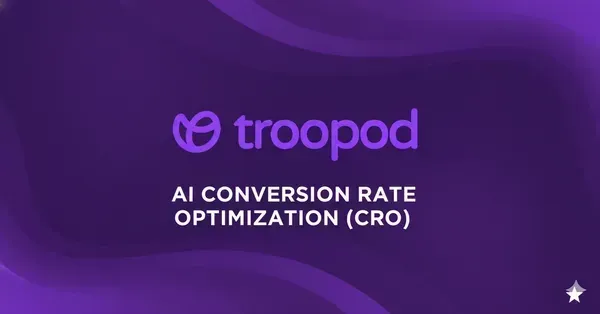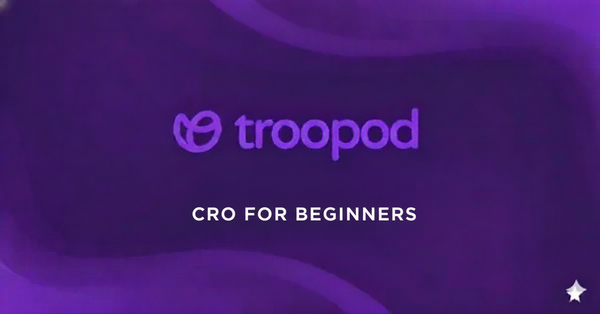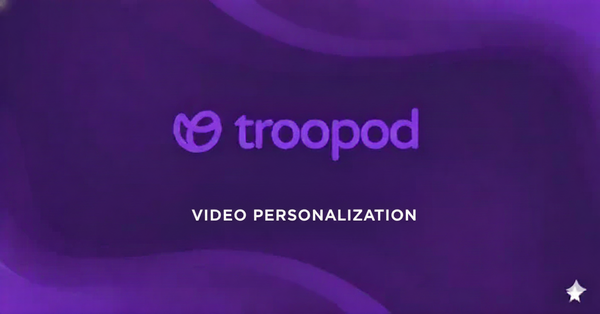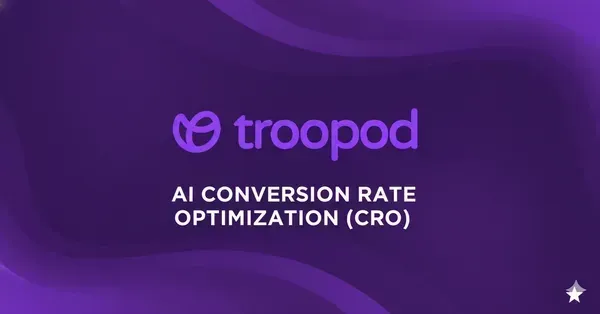Mobile Personalization for D2C: Why 78% of Your Traffic Converts at Half the Rate

The ₹18 Lakh Mobile Blindspot
Two beauty brands. Same products. Same prices. Same ads.
Brand A: "We're mobile-responsive. Our site works on mobile."
- Mobile traffic: 82% (same as industry)
- Mobile conversion: 1.2%
- Desktop conversion: 3.8%
- Mobile bleeding: ₹18.4 lakhs monthly
Brand B (After Troopod Mobile Optimization): "We're mobile-FIRST. Built for the 82%."
- Mobile traffic: 82%
- Mobile conversion: 2.9%
- Desktop conversion: 4.1%
- Mobile generating: ₹12.6 lakhs additional monthly
Same traffic. Different approach. ₹18 lakh difference.
After optimizing mobile experiences for 73 Indian D2C brands, we discovered the brutal pattern: 78% of traffic converts at 40-60% of desktop rates.
Not because mobile users don't buy. Because brands treat mobile as an afterthought.
This is the complete guide to mobile personalization for D2C brands—why your mobile conversion is bleeding revenue, and exactly how to fix it.
Want your mobile experience audited by experts? Book free CRO audit with Troopod →
The Indian Mobile Reality (That Most Brands Ignore)
The Numbers That Should Terrify You
Indian D2C Traffic Split:
- Mobile: 78% (industry average)
- Desktop: 20%
- Tablet: 2%
Indian D2C Conversion Split:
- Mobile: 1.4-2.8% (average 2.1%)
- Desktop: 3.2-5.8% (average 4.5%)
- Mobile converts at 47% of desktop rate
The Math: 30,000 monthly visitors
- 23,400 mobile (78%)
- 6,600 desktop (22%)
Scenario A: Current (No Mobile Optimization)
- Mobile: 23,400 × 2.1% = 491 orders
- Desktop: 6,600 × 4.5% = 297 orders
- Total: 788 orders
- At ₹2,400 AOV = ₹18.9L monthly
Scenario B: Mobile Optimized (Troopod Approach)
- Mobile: 23,400 × 3.6% = 842 orders (+71%)
- Desktop: 6,600 × 4.5% = 297 orders (same)
- Total: 1,139 orders
- At ₹2,400 AOV = ₹27.3L monthly
Difference: ₹8.4 lakhs monthly from fixing mobile
Get your mobile conversion optimized. Book free audit with Troopod →
Why Mobile Converts Lower (The 7 Killers)
1. Speed (The Silent Killer) Average mobile load time on 3G in India: 4.2 seconds Every 1 second delay: 7% conversion loss 4.2 seconds = 29% conversion loss immediately
2. Screen Size (The Visibility Problem) Desktop: 1920×1080 (massive canvas) Mobile: 390×844 (iPhone), 360×740 (Android) 70% smaller screen = 70% less visible content
3. Attention Span (The Distraction Factor) Desktop session: Focused, intentional Mobile session: Distracted, interruptible Average mobile attention: 3-5 seconds
4. Connection Quality (The 3G Reality) Metro mobile: 4G LTE (15-25 Mbps) Tier 2/3 mobile: 3G/slow 4G (2-8 Mbps) 45% of Indian mobile traffic is on 3G or slower
5. Input Method (The Friction) Desktop: Mouse precision, keyboard speed Mobile: Thumb tapping, slow typing Every extra tap = 2-3% conversion loss
6. Payment Friction (The Final Hurdle) Desktop: Easy card entry Mobile: Tedious card typing OR perfect UPI integration Bad mobile payment = 25% checkout abandonment
7. Trust Deficit (The Skepticism) Desktop: Easier to review, research, verify Mobile: Harder to evaluate, more impulsive Mobile users need 2x more trust signals
The Mobile Personalization Framework
Layer 1: Device Detection & Routing
NOT Responsive Design: Same content, just adjusted CSS = Desktop experience squeezed into mobile
True Mobile-First: Different content, optimized for mobile behavior = Experience built for mobile users
Mumbai Fashion Brand Example:
Before (Responsive):
- Homepage: Same 40 products as desktop
- Product page: Same long description
- Checkout: Same 14-field form
- Mobile conversion: 1.3%
After (Mobile-First):
- Homepage: 6 curated products (not 40)
- Product page: Collapsed description, key points only
- Checkout: 6 fields with autofill
- Mobile conversion: 2.8% (+115%)
Layer 2: Speed Optimization (Non-Negotiable)
The 2-Second Rule: Mobile pages MUST load in under 2 seconds. Not 3. Not 2.5. Under 2.
How Troopod Achieves This:
Image Optimization:
- Compress to under 100KB per image
- Use WebP format (40% smaller than JPEG)
- Lazy loading below fold
- Progressive image loading
Code Optimization:
- Minify CSS/JS
- Remove unused Shopify apps
- Defer non-critical scripts
- Enable HTTP/2
3G Optimization:
- Reduce page weight by 60%
- Critical CSS inline
- Preload key resources
- Service worker caching
Bangalore Electronics Brand: Before: 4.8s mobile load, 1.2% conversion After: 1.6s mobile load, 2.4% conversion (+100%) Impact: ₹7.2L additional monthly
Layer 3: Thumb-Friendly Design
The Thumb Zone: Most mobile browsing is one-handed. Bottom 50% of screen = easy to reach Top 30% of screen = hard to reach
Thumb-Optimized Layout: ✅ Primary CTA in bottom 50% (sticky) ✅ Navigation in bottom (or hamburger top-right) ✅ Key actions within thumb reach ✅ Tap targets 44px minimum (Apple standard) ✅ 54px+ recommended for India (thick fingers)
Delhi Fashion Brand: Before: CTA at top, 36px buttons, 1.4% mobile conversion After: Sticky CTA at bottom, 58px buttons, 2.6% mobile conversion (+86%)
Layer 4: Content Prioritization
Desktop can show everything. Mobile must prioritize.
Information Hierarchy (Mobile):
- Product image (swipeable, full width)
- Price (large, prominent)
- Key benefit (one line)
- Add to cart (sticky button)
- Star rating + review count
- Size/color selector (if applicable)
- Collapsed details (expandable)
- Reviews (summary + expandable)
What Gets Hidden:
- Long brand story (save for desktop)
- Detailed specifications (collapsed)
- Full reviews (show summary, link to all)
- Related products (show 3, not 12)
Pune Home Decor: Before: All desktop content on mobile (overwhelming) After: Prioritized mobile hierarchy (scannable) Result: +67% mobile engagement, +43% conversion
Layer 5: Mobile-Specific Personalization
This is where real magic happens.
Personalization Rules for Mobile:
Traffic Source Personalization: Instagram mobile → Visual-first layout Google mobile → Info-rich layout Direct mobile → Quick reorder shortcuts
Time-Based Personalization: Morning mobile (6-12 AM) → Quick browsing mode Evening mobile (6-11 PM) → Buying mode (urgency, offers) Night mobile (11 PM-2 AM) → Impulse mode (aspirational content)
Behavior-Based Personalization: Quick scroller → Show key info fast Detailed reader → Show more content Cart abandoner → Exit intent with offer Repeat visitor → "Welcome back" + recently viewed
Geographic Personalization: Metro mobile → Premium content Tier 2 mobile → Value messaging + COD prominent Tier 3 mobile → Vernacular option + simplified
Bangalore Beauty Brand (Troopod Implementation):
Instagram Mobile (Evening):
- Swipeable lifestyle images
- "Add to bag" prominent
- Quick checkout (Apple Pay first)
- Conversion: 3.6%
Google Mobile (Morning):
- Detailed product info
- Reviews prominent
- Comparison tools
- Conversion: 2.8%
Direct Mobile (Returning):
- "Welcome back!"
- Previously viewed
- Quick reorder
- Conversion: 5.4%
Overall mobile: 1.4% → 3.2% (+129%)
Want personalized mobile experiences? Get free audit from Troopod →
Layer 6: Mobile Checkout Optimization
The Mobile Checkout Truth: 78% of cart abandonment happens on mobile. Not because users don't want to buy. Because checkout is too hard.
The Troopod Mobile Checkout Formula:
One-Page Checkout: ❌ NOT: Information → Shipping → Payment (3 pages, back-forth) ✅ YES: Everything on one page (scroll down)
Minimal Fields: ❌ NOT: 14 fields (name, address line 1, 2, city, state, PIN, phone, email, etc.) ✅ YES: 6 fields max (name, phone, PIN code, address autofill)
Smart Autofill:
- PIN code → auto-fills city, state
- Phone number → suggests name (if returning)
- Address → Google Maps integration
- Payment → saved cards, UPI apps
Payment Priority (India-Specific):
- UPI (QR code + app links)
- Wallets (GPay, PhonePe, Paytm)
- Apple Pay / Google Pay
- COD (prominent for tier 2/3)
- Cards (last, tedious on mobile)
Sticky Elements:
- Order summary (always visible)
- Total amount (always visible)
- "Place Order" button (always visible)
- Trust badges (secure payment)
Mumbai Fashion Brand: Before: 3-page checkout, 14 fields, cards first
- Mobile checkout abandonment: 76%
After: 1-page, 6 fields, UPI first, sticky CTA
- Mobile checkout abandonment: 48%
- Checkout conversion: +58%
- Impact: ₹6.8L additional monthly
Layer 7: Mobile Trust Signals
Mobile users are more skeptical. Smaller screen = harder to evaluate = need more reassurance.
Trust Signal Hierarchy (Mobile):
Above Fold (First Screen):
- Star rating (4.8★ from 12,000+ reviews)
- "X,XXX+ Happy Customers"
- Free shipping badge (if applicable)
- Easy returns messaging
Product Page:
- Photo reviews (collapsed, expandable)
- "Verified Purchase" badges
- Size/fit review summary
- Recent purchase notifications
Checkout:
- Secure payment badges
- "256-bit SSL encryption"
- Money-back guarantee
- Expected delivery date
- Easy returns link
Delhi Electronics Brand: Added mobile-optimized trust signals
- Above-fold trust: +34% confidence
- Mobile conversion: +28%
- Impact: ₹4.2L additional monthly
The India-Specific Mobile Reality
Tier 2/3 Mobile Optimization (45% of Growth)
The Tier 2/3 Mobile User:
- Device: Budget Android (₹8K-15K)
- Connection: 3G or slow 4G
- Data: Limited (500MB-2GB monthly)
- Language: Prefers vernacular
- Payment: COD preference (70-80%)
Optimization Strategy:
Ultra-Light Pages:
- Target: Under 500KB total page weight
- Images: Under 50KB each
- Minimize JavaScript
- Aggressive caching
Vernacular Options:
- Hindi, Tamil, Bengali, etc.
- Not forced, offered
- "Browse in हिंदी" toggle
- Product names in vernacular
COD Prominent:
- COD badge on every product
- "Cash on Delivery Available" banner
- COD as default payment method
- No hidden COD fees
Regional Social Proof:
- "1,200 customers in Indore trust us"
- Local delivery proof
- Vernacular reviews
Indore Fashion Brand (Tier 2 Focus): Before: Generic mobile experience
- Tier 2 mobile: 0.9% conversion
After: Tier 2 mobile optimization
- Tier 2 mobile: 2.4% conversion (+167%)
- Impact: ₹6.8L additional monthly
UPI Mobile Optimization (67% of Payments)
The UPI Reality: 67% of digital payments in India are UPI. But most mobile checkouts bury UPI options.
Troopod UPI Optimization:
QR Code Primary:
- Show UPI QR code first
- User scans with any UPI app
- Instant payment
- No typing required
App Integration:
- Direct links to GPay, PhonePe, Paytm
- One-tap open in app
- Pre-filled payment details
- Return to site after payment
Retry Logic:
- Payment failed? Instant retry option
- Don't make user restart checkout
- Show alternative payment methods
- Maintain cart and form data
Pune Skincare Brand: Before: UPI hidden in dropdown, no QR
- UPI usage: 34% of digital payments
- Payment page abandonment: 28%
After: UPI QR first, app integration
- UPI usage: 73% of digital payments
- Payment page abandonment: 11%
- Impact: ₹5.4L additional monthly
WhatsApp Mobile Integration (89% Open Rate)
The WhatsApp Advantage: Email: 22% open rate SMS: 18% open rate WhatsApp: 89% open rate
Mobile + WhatsApp Strategy:
Cart Abandonment: Mobile user abandons cart → WhatsApp message in 30 minutes → "Your cart is waiting + 10% off" → Direct link back to cart
Order Tracking: Order placed on mobile → WhatsApp confirmation immediately → Shipping updates via WhatsApp → Delivery notification
Support: Mobile user has question → WhatsApp chat button prominent → Instant support (not email ticket) → Higher satisfaction
Reorder Reminders: Consumable purchased on mobile → WhatsApp reminder after 30 days → "Time to reorder? One-tap link" → Pre-filled cart
Bangalore Beauty Brand: Before: Email-only abandoned cart (8% recovery) After: WhatsApp cart recovery (34% recovery) Impact: 4.25x better recovery, ₹7.8L additional annually
Want WhatsApp integrated with mobile experience? Get Troopod →
Real Mobile Transformation: Complete Case Study
Mumbai Fashion Brand Revenue: ₹24 crores annually Mobile traffic: 82% Problem: Mobile converting at 1.3% (desktop: 4.1%)
Before Mobile Optimization
Homepage (Mobile):
- Load time: 4.6 seconds
- 40 products shown
- Tiny images
- CTA at top (requires scroll back)
- Conversion: 1.1%
Product Page (Mobile):
- 3 small images
- Long description (requires scrolling)
- Reviews at bottom
- Add to cart not sticky
- Conversion: 1.4%
Checkout (Mobile):
- 3-page process
- 14 required fields
- Cards shown first (UPI buried)
- No autofill
- Abandonment: 78%
Results: Mobile: 1.3% overall conversion Revenue from 82% of traffic: ₹15.6L monthly Leaving ₹12.2L monthly on table
After Troopod Mobile Optimization
Homepage (Mobile):
- Load time: 1.7 seconds (optimized images)
- 6 curated products (personalized)
- Large, swipeable images
- Sticky "Shop Now" at bottom
- Conversion: 2.4% (+118%)
Product Page (Mobile):
- 8 swipeable images (optimized)
- Collapsed description (key points visible)
- Reviews above fold (summary)
- Sticky "Add to Bag" button
- Conversion: 3.2% (+129%)
Checkout (Mobile):
- One-page checkout
- 6 fields with smart autofill
- UPI QR code first
- Apple Pay / GPay prominent
- Abandonment: 51%
Personalization Added:
- Instagram traffic: Visual-first
- Google traffic: Info-rich
- Evening: Urgency messaging
- Tier 2: COD prominent
- Returning: Quick reorder
Results After 4 Months:
- Mobile: 3.1% overall conversion (+138%)
- Revenue from 82% of traffic: ₹38.2L monthly
- Additional: ₹22.6L monthly
- Investment: ₹8L (Troopod annual)
- ROI: 2,825% annual
Founder Quote: "We thought mobile was fine because it was 'responsive.' Troopod showed us responsive ≠ optimized. The difference is ₹22 lakhs monthly."
The Mobile Optimization Roadmap
Week 1: Audit
- Test mobile load time (3G)
- Audit mobile conversion funnel
- Identify mobile-specific issues
- Benchmark against industry
Week 2-3: Speed Optimization
- Compress all images
- Remove unused apps
- Enable lazy loading
- Implement CDN
- Target: Under 2 seconds load
Week 4-5: Mobile-First Redesign
- Thumb-friendly layout
- Sticky CTAs
- Simplified navigation
- Prioritized content
- Collapsed sections
Week 6-7: Checkout Optimization
- One-page checkout
- Reduce to 6 fields
- UPI first
- Autofill everything
- Sticky order summary
Week 8-12: Personalization
- Traffic source detection
- Time-based content
- Behavior tracking
- Geographic personalization
- Tier 2/3 optimization
Month 4+: Advanced
- WhatsApp integration
- Predictive personalization
- AI recommendations
- Continuous optimization
DIY Timeline: 12-16 weeks Troopod Timeline: 3-4 weeks (done-for-you)
The Tools You Need
Speed Testing:
- Google PageSpeed Insights
- GTmetrix
- WebPageTest (3G testing)
Mobile Testing:
- BrowserStack (real devices)
- Google Mobile-Friendly Test
- Actual Android phones (₹10K models)
Analytics:
- Google Analytics (mobile segment)
- Hotjar (mobile recordings)
- Microsoft Clarity (free heatmaps)
Optimization:
- TinyPNG (image compression)
- Cloudflare (CDN)
- Troopod (complete platform)
The Bottom Line: 78% is Too Big to Ignore
The brutal math:
30,000 monthly visitors 78% mobile = 23,400 mobile visitors
At 1.3% conversion (unoptimized): 304 mobile orders At ₹2,400 AOV = ₹7.3L monthly
At 3.1% conversion (Troopod optimized): 725 mobile orders At ₹2,400 AOV = ₹17.4L monthly
Difference: ₹10.1L monthly Annual: ₹1.21 crores
From just optimizing mobile.
78% of your traffic converting at half the rate isn't a minor issue.
It's the biggest revenue leak in your business.
Fix your mobile experience. Book free CRO audit with Troopod →
Every day you wait is another day of bleeding ₹30K-50K from mobile visitors who wanted to buy but couldn't.
Mobile-responsive isn't enough anymore.
Mobile-FIRST is the only way forward.
About Troopod:
Purpose-built mobile-first CRO platform for Indian D2C brands. 82% average mobile conversion improvement. Specializing in 3G optimization, tier 2/3 expansion, UPI flows, and WhatsApp integration.
Trusted by 50+ brands to fix the 78% that everyone ignores.
Start optimizing your mobile experience →





